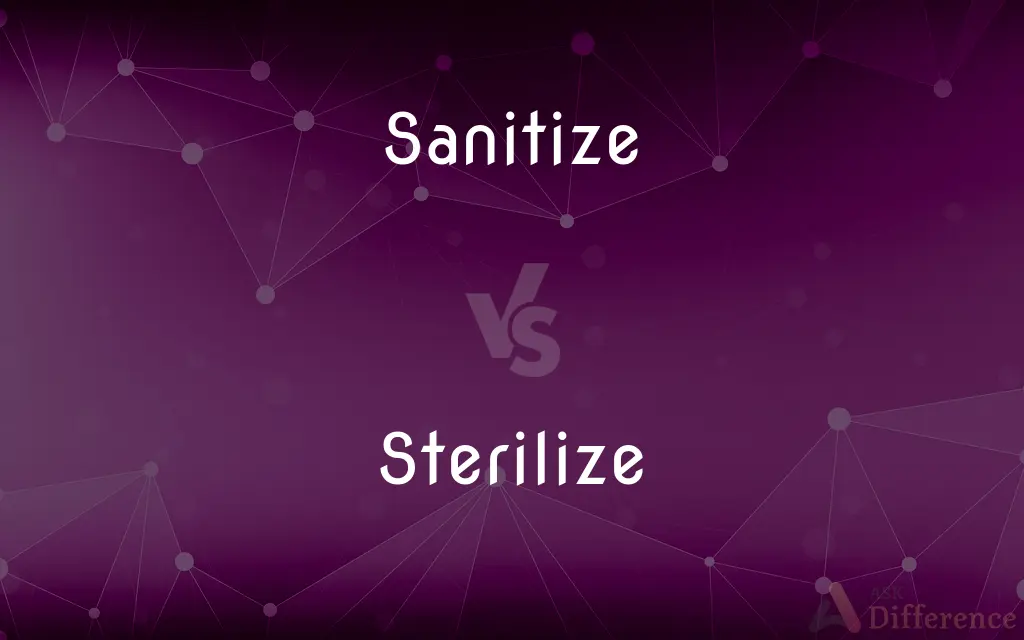Sanitize vs. Sterilize — What's the Difference?
By Tayyaba Rehman & Maham Liaqat — Updated on April 16, 2024
Sanitizing reduces bacteria to safe levels on surfaces through cleaning, while sterilizing kills all microorganisms using more intensive methods.

Difference Between Sanitize and Sterilize
Table of Contents
ADVERTISEMENT
Key Differences
Sanitizing typically reduces bacteria on surfaces to levels considered safe by public health standards, typically using chemicals or heat. Whereas sterilizing goes further, aiming to kill all forms of microbial life, including bacteria, viruses, and fungi, often used in medical and laboratory environments.
Sanitizing is generally quicker and less harsh, suitable for everyday items like kitchen counters and toys. On the other hand, sterilizing involves processes like autoclaving or using high concentrations of chemicals, essential for surgical instruments and laboratory tools.
Sanitizing can be achieved with simple methods such as wiping with an antibacterial solution or using a dishwasher on a sanitize cycle. While sterilizing requires specific conditions, such as steam under pressure, dry heat, or chemical vapor, which are not practical for routine home use.
Sanitizing is often sufficient for maintaining cleanliness in homes and restaurants to prevent disease transmission. In contrast, sterilizing is mandatory in scenarios where absolute sterility is required, such as during surgical procedures or in sterile manufacturing environments.
Sanitizing agents include products like bleach diluted in water or alcohol solutions. Whereas sterilizing agents are more potent and include methods such as ethylene oxide gas or hydrogen peroxide plasma.
ADVERTISEMENT
Comparison Chart
Objective
Reduces bacteria to safe levels
Kills all microorganisms
Common Uses
Kitchens, toys, general home surfaces
Surgical instruments, lab tools
Methods
Chemical wipes, low heat, dishwashers
Autoclaves, chemical vapor, dry heat
Suitable for
Everyday items, non-critical environments
Critical environments, healthcare settings
Example Agents
Bleach solutions, alcohol wipes
Ethylene oxide, hydrogen peroxide plasma
Compare with Definitions
Sanitize
A less intense form of germ control than sterilizing.
After playing outside, the daycare worker sanitized the children's hands.
Sterilize
The process of destroying all microbial life.
Sterilizing baby bottles ensures they are completely free of harmful bacteria.
Sanitize
The process of reducing germs to a safe level.
Restaurants are required to sanitize dishes and utensils after each use.
Sterilize
To make something free from all germs and other living microorganisms.
The surgical tools must be sterilized before they can be used in the operating room.
Sanitize
To make something clean and hygienic.
To prepare for dinner, she sanitized the kitchen counters.
Sterilize
Used in medical and scientific settings to ensure absolute sterility.
Before being packaged, the medical implants were sterilized.
Sanitize
Make clean and hygienic; disinfect
New chemicals for sanitizing a pool
Sterilize
Make (something) free from bacteria or other living microorganisms
Babies' feeding equipment can be cleaned and sterilized
Sanitize
To make sanitary, as by cleaning or disinfecting.
Sterilize
To make free from live bacteria or other microorganisms.
Sanitize
To make more acceptable by removing unpleasant or offensive features from
Sanitized the language in adapting the novel for television.
Sterilize
To eliminate the ability of a person or animal to produce offspring, as by altering or removing the reproductive organs.
Sanitize
(transitive) To rid of microorganisms by cleaning or disinfecting.
Sterilize
To make incapable of bearing fruit or germinating.
Sanitize
To make something, such as a dramatic work, more acceptable by removing potentially offensive material.
Sterilize
To render (land) unfruitful.
Sanitize
To filter (text) to ensure it does not contain any characters that will cause problems for or be interpreted in an adverse way by the receiving system.
Sterilize
(Economics) To place (gold) in safekeeping so as not to affect the supply of money or credit.
Sanitize
To remove sensitive or personal data from (a database or file).
Sterilize
To make inoffensive or innocuous
Sterilized the terminology with euphemisms.
Sanitize
(transitive) To revise (a document) in order to prevent identification of the sources.
Sterilize
(transitive) To deprive of the ability to procreate.
Sanitize
Make sanitary by cleaning or sterilizing
Sterilize
(transitive) To make unable to produce; to make unprofitable.
Sanitize
Make less offensive or more acceptable by removing objectionable features;
Sanitize a document before releasing it to the press
Sanitize history
Sanitize the language in a book
Sterilize
To kill, deactivate (denature), or destroy (break apart) all living, viable microorganisms and spores on a surface, in a fluid, or contained in a compound, such as culture media or a medical product.
Sterilize
(transitive) To redact (a document), removing classified or sensitive material.
Sterilize
To make sterile or unproductive; to impoverish, as land; to exhaust of fertility.
Sterilize
To deprive of the power of reproducing; to render incapable of germination or fecundation; to make sterile.
Sterilize
To destroy all spores or germs in (an organic fluid or mixture) or on (a medical instrument), as by heat, so as to prevent contamination by bacteria or other organisms. A common method of sterilization in laboratories and medical facilities is to heat a liquid sample or an instrument in an autoclave.
Sterilize
To destroy all spores or germs on (a surface) by wetting with an antiseptic liquid, such as an alcoholic solution.
Sterilize
Make free from bacteria
Sterilize
Make infertile;
In some countries, people with genetically transmissible disbilites are sterilized
Common Curiosities
What are common methods of sterilizing?
Common methods include autoclaving, using chemical vapors, or applying dry heat.
What does sanitize mean?
Sanitize means to clean something, especially by killing or removing bacteria to reduce them to a safe level.
Is sterilizing necessary for household kitchens?
Typically, sterilizing is not necessary for household kitchens; sanitizing is usually sufficient.
What does sterilize mean?
Sterilize means to make something completely free from bacteria, viruses, and all other microorganisms.
Is alcohol a good sanitizer?
Yes, alcohol solutions are effective sanitizers and are widely used for cleaning surfaces.
Can sanitizing replace sterilizing?
No, sanitizing reduces bacteria to safe levels but does not eliminate all microorganisms, unlike sterilizing.
Can I use bleach for sterilizing?
Bleach can be used for sanitizing but is generally not suitable for sterilizing, as it does not kill all microbial life.
What risks are associated with insufficient sterilization?
Insufficient sterilization can lead to infections, particularly in medical settings where sterile conditions are critical.
Can I sterilize surgical instruments at home?
It is not recommended to sterilize surgical instruments at home as it requires specific equipment and conditions.
What temperatures are used to sterilize equipment?
Temperatures for sterilizing equipment typically exceed 121 degrees Celsius (250 degrees Fahrenheit).
What is the difference between a dishwasher's sanitize and normal cycles?
The sanitize cycle uses higher temperatures or additional sanitizing agents to reduce bacteria more effectively than normal cycles.
How often should restaurant surfaces be sanitized?
Restaurant surfaces should be sanitized regularly, typically after each use or exposure to potential contamination.
What is the main goal of sanitizing?
The main goal of sanitizing is to lower the number of germs to a safe level to prevent infection.
Are there any eco-friendly sanitizers?
Yes, there are eco-friendly sanitizers made from natural ingredients like vinegar or citrus extracts that are effective at reducing bacteria on surfaces.
How do hospitals ensure tools are sterilized?
Hospitals use methods like autoclaving and chemical sterilants to ensure all tools are free from microorganisms.
Share Your Discovery

Previous Comparison
Tercile vs. Quantile
Next Comparison
Triumphant vs. TriumphAuthor Spotlight
Written by
Tayyaba RehmanTayyaba Rehman is a distinguished writer, currently serving as a primary contributor to askdifference.com. As a researcher in semantics and etymology, Tayyaba's passion for the complexity of languages and their distinctions has found a perfect home on the platform. Tayyaba delves into the intricacies of language, distinguishing between commonly confused words and phrases, thereby providing clarity for readers worldwide.
Co-written by
Maham Liaqat













































